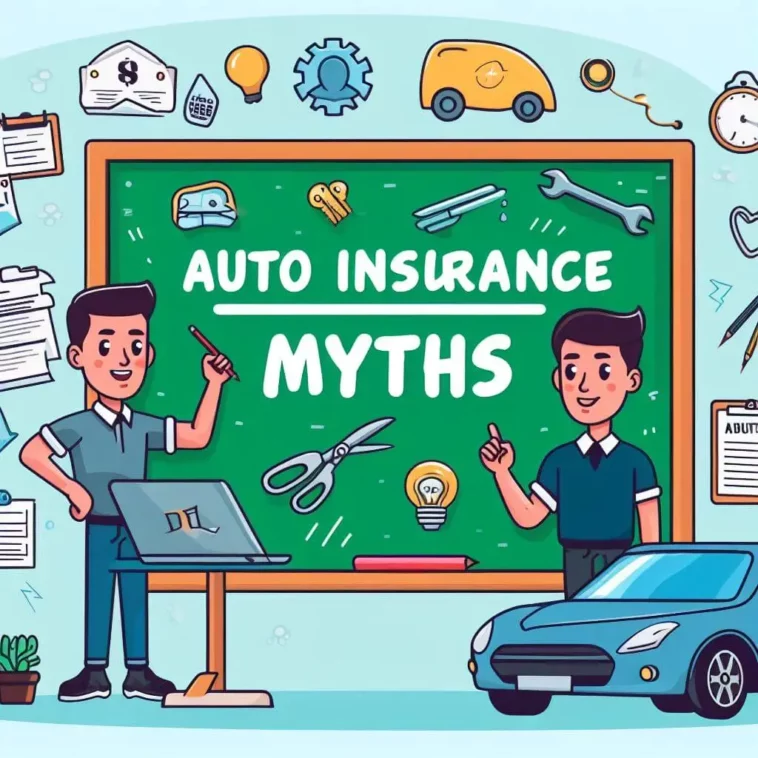Introduction
In this article, we’ll debunk some of the most common auto insurance myths and misconceptions. We’ll also provide tips for getting the most out of your auto insurance policy and saving money on your premiums.
Auto insurance is a mandatory expense for most car owners, but it can be a complex and confusing topic. There are many different types of coverage available, and it can be difficult to know which ones you need and how much to pay. This is especially true if you’re new to car ownership or if you’ve recently moved to a new state.
To make matters worse, there are a lot of common myths and misconceptions about auto insurance. These myths can lead people to make poor decisions about their coverage, which can leave them financially vulnerable in the event of an accident.
These myths can be harmful because they can lead people to make uninformed decisions about their auto insurance coverage. For example, if you believe that the color of your car affects your insurance rates, you may choose to buy a car that is a different color than the one you really want. Or, if you believe that you only need to carry the minimum amount of auto liability insurance required by law, you may find yourself financially devastated if you’re involved in a serious accident.
In the next section of this article, we’ll debunk each of these myths and misconceptions one at a time. We’ll also provide tips for getting the most out of your auto insurance policy and saving money on your premiums.
Common auto insurance myths and misconceptions
In this article, we’ll debunk some of the most common auto insurance myths and misconceptions. We hope this will help you to better understand your coverage and make informed decisions about your auto insurance policy.
These are the most common auto insurance myths and misconceptions
Myth #1: Red cars cost more to insure than other colors.
This myth is false. Your car’s color has no bearing on your auto insurance rates. Insurance companies consider other factors, such as the make and model of your car, your driving record, and your age, when setting your rates.
Myth #2: The more expensive the car, the more it costs to insure.
This myth is also false. The cost of your car doesn’t necessarily dictate how much you’ll pay for insurance. For example, a sports car may be more expensive to insure than a minivan, but a new minivan may be more expensive to insure than an older sports car.
Myth #3: Getting a traffic ticket will automatically increase the price of your premiums.
Not necessarily. While a traffic ticket can raise your rates, it doesn’t always. Insurance companies weigh a variety of factors when determining your rates, including the type of ticket you received, how long ago you received it, and your overall driving record.
Myth #4: You only need to carry the minimum amount of auto liability insurance required by law.
This myth is dangerous. The minimum amount of auto liability insurance required by law is often not enough to cover the cost of damages in a serious accident. If you’re at fault for an accident and your insurance coverage isn’t enough to cover the damages, you could be held personally liable for the remaining costs.
Myth #5: If you’re involved in an accident that’s not your fault, the other driver’s insurance company will cover all of your damages.
This myth is not always true. If the other driver doesn’t have enough insurance coverage, or if they’re uninsured, you may be left to pay for some or all of your damages out of pocket. That’s why it’s important to have collision coverage and uninsured/underinsured motorist coverage on your own auto insurance policy.
Myth #6: Your insurance rates will stay the same if you have a clean driving record.
This myth is not always true. Insurance companies can change your rates at any time, even if you have a clean driving record. For example, if your insurance company experiences an increase in claims, they may raise rates for all of their customers. Additionally, insurance companies may also raise rates for customers who live in areas with a high rate of accidents or who drive certain types of cars.
Myth #7: You can’t cancel your auto insurance policy at any time.
This myth is false. You can cancel your auto insurance policy at any time, but you may have to pay a cancellation fee. It’s important to check your policy for the cancellation terms and conditions.
Myth #8: You have to file a claim with your own insurance company if you’re involved in an accident, even if it’s not your fault.
This myth is false. If the other driver is at fault for the accident, you can file a claim with their insurance company. In fact, it’s usually best to file a claim with the other driver’s insurance company, if possible. This is because your insurance company may raise your rates if you file a claim, even if it’s not your fault.
Myth #9: You can’t switch insurance companies if you have a claim pending.
This myth is false. You can switch insurance companies at any time, even if you have a claim pending. However, your new insurance company may not be able to cover your claim if it was filed with your previous insurance company.
Myth #10: Your auto insurance premiums will go up if you file a claim.
This myth is not always true. Whether or not your premiums will go up after filing a claim depends on a number of factors, such as the type of claim you filed, how many claims you’ve filed in the past, and your insurance company’s claims policy.

Common Auto Insurance Myths and Misconceptions FAQs
Q: What are the factors that affect my auto insurance rates?
A: The following factors can affect your auto insurance rates:
- Your age
- Your driving record
- Your credit history
- The make and model of your car
- Where you live
- How much you drive
Q: How can I get the best deal on auto insurance?
A: There are a few things you can do to get the best deal on auto insurance:
- Shop around and compare quotes from multiple insurance companies.
- Take advantage of discounts, such as good driver discounts, multi-policy discounts, and military discounts.
- Raise your deductible. Increasing your deductible can lower your monthly premiums, but it’s important to make sure you can afford to pay your deductible if you need to file a claim.
Q: What should I do if I’m involved in a car accident?
A: If you’re involved in a car accident, you should:
- Check yourself and any passengers for injuries.
- If anyone is injured, call 911.
- Move your vehicle to a safe location, if possible.
- Exchange contact information with the other driver(s) involved in the accident.
- Take photos and videos of the damage to your vehicle.
- File a police report.
- Contact your insurance company to file a claim.
Q: What should I do if I have a claim with my insurance company?
A: If you have a claim with your insurance company, you should:
- Be honest and accurate when providing information about the claim.
- Cooperate with your insurance company’s investigation.
- Keep a record of all communications with your insurance company.
Q: How can I cancel my auto insurance policy?
A: To cancel your auto insurance policy, you should contact your insurance company and request a cancellation. You may be required to pay a cancellation fee.
Myths about auto insurance can be misleading and costly.
Here are some common auto insurance myths and misconceptions debunked:
Myth: Red cars cost more to insure than other colors.
Fact: The color of your car has no bearing on your auto insurance rates. Insurance companies consider other factors, such as the make and model of your car, your driving record, and your age, when setting your rates.
Myth: The more expensive the car, the more it costs to insure.
Fact: The cost of your car doesn’t necessarily dictate how much you’ll pay for insurance. For example, a sports car may be more expensive to insure than a minivan, but a new minivan may be more expensive to insure than an older sports car.
Myth: Getting a traffic ticket will automatically increase the price of your premiums.
Fact: Not necessarily. While a traffic ticket can raise your rates, it doesn’t always. Insurance companies weigh a variety of factors when determining your rates, including the type of ticket you received, how long ago you received it, and your overall driving record.
Myth: You only need to carry the minimum amount of auto liability insurance required by law.
Fact: This myth is dangerous. The minimum amount of auto liability insurance required by law is often not enough to cover the cost of damages in a serious accident. If you’re at fault for an accident and your insurance coverage isn’t enough to cover the damages, you could be held personally liable for the remaining costs.
Myth: If you’re involved in an accident that’s not your fault, the other driver’s insurance company will cover all of your damages.
Fact: This myth is not always true. If the other driver doesn’t have enough insurance coverage, or if they’re uninsured, you may be left to pay for some or all of your damages out of pocket. That’s why it’s important to have collision coverage and uninsured/underinsured motorist coverage on your own auto insurance policy.
It’s important to debunk these myths so that you can make informed decisions about your auto insurance coverage. By understanding the facts, you can avoid overpaying for coverage you don’t need and ensure that you have the coverage you need to protect yourself financially in the event of an accident.
common auto insurance myths and misconceptions Conclusion
Auto insurance is a complex topic, and it’s easy to get confused about all the different coverage options and requirements. As a result, there are a lot of myths and misconceptions about auto insurance.
In this article, we’ve debunked some of the most common auto insurance myths and misconceptions. We hope this has helped you to better understand your coverage and make informed decisions about your auto insurance policy.
Here are some key common auto insurance myths and misconceptions from this article:
- The color of your car and the cost of your car do not necessarily affect your insurance rates.
- Getting a traffic ticket may raise your rates, but it doesn’t always.
- You should carry more than the minimum amount of auto liability insurance required by law.
- If you’re involved in an accident that’s not your fault, you may be able to file a claim with the other driver’s insurance company.
- Your insurance rates may change at any time, even if you have a clean driving record.
- You can cancel your auto insurance policy at any time, but you may have to pay a cancellation fee.
- You don’t have to file a claim with your own insurance company if you’re involved in an accident, even if it’s not your fault.
- You can switch insurance companies at any time, even if you have a claim pending.
- Your auto insurance premiums may go up after filing a claim, but it’s not always the case.
Now that you have a better understanding of auto insurance, you can make informed decisions about your coverage. Be sure to shop around and compare quotes from multiple insurance companies to find the best deal for your needs.
Here are some additional tips for getting the most out of your auto insurance policy:
- Review your policy regularly to make sure you have the right coverage for your needs.
- Take advantage of discounts, such as good driver discounts, multi-policy discounts, and military discounts.
- Raise your deductible to lower your monthly premiums.
- Bundle your auto insurance with other types of insurance, such as home insurance or life insurance, to save money.
- Ask your insurance company about any other ways to save money on your policy.
By following these tips, you can get the most out of your auto insurance policy and save money on your premiums.
Finally, recommend you checking our insurance blog more specifically our auto insurance blog
Popular Insurance Reviews
- dan travel insurance reviews
- otto insurance reviews
- safepoint insurance reviews
- platinum supplemental insurance reviews
- southern oak insurance reviews
- arrowhead insurance review
- brightway insurance franchise reviews
- john hancock travel insurance reviews
- hippo home insurance reviews
- pawp pet insurance reviews
Popular articles
- what insurance company covers mounjaro
- will insurance cover ozempic for prediabetes
- how much do dentures cost without insurance
- how to make a successful water leak insurance claim
- How to file a business insurance claim
- business insurance types
- does insurance cover hail damage
- how to reduce the cost of your auto insurance
- When was the first car accident?
- what state has the most car accidents



